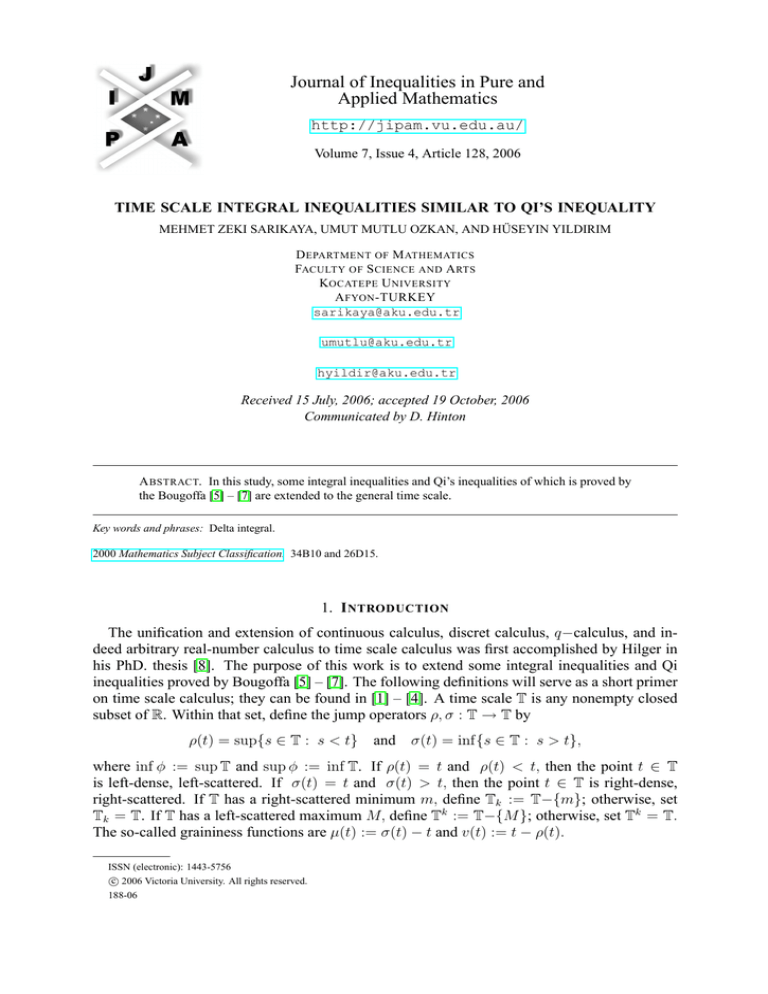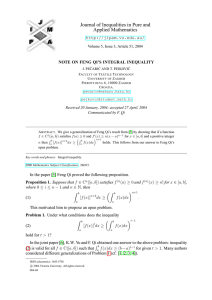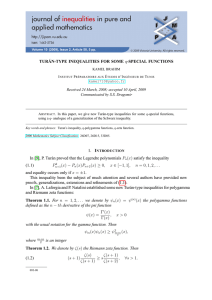
Journal of Inequalities in Pure and
Applied Mathematics
http://jipam.vu.edu.au/
Volume 7, Issue 4, Article 128, 2006
TIME SCALE INTEGRAL INEQUALITIES SIMILAR TO QI’S INEQUALITY
MEHMET ZEKI SARIKAYA, UMUT MUTLU OZKAN, AND HÜSEYIN YILDIRIM
D EPARTMENT OF M ATHEMATICS
FACULTY OF S CIENCE AND A RTS
KOCATEPE U NIVERSITY
A FYON -TURKEY
sarikaya@aku.edu.tr
umutlu@aku.edu.tr
hyildir@aku.edu.tr
Received 15 July, 2006; accepted 19 October, 2006
Communicated by D. Hinton
A BSTRACT. In this study, some integral inequalities and Qi’s inequalities of which is proved by
the Bougoffa [5] – [7] are extended to the general time scale.
Key words and phrases: Delta integral.
2000 Mathematics Subject Classification. 34B10 and 26D15.
1. I NTRODUCTION
The unification and extension of continuous calculus, discret calculus, q−calculus, and indeed arbitrary real-number calculus to time scale calculus was first accomplished by Hilger in
his PhD. thesis [8]. The purpose of this work is to extend some integral inequalities and Qi
inequalities proved by Bougoffa [5] – [7]. The following definitions will serve as a short primer
on time scale calculus; they can be found in [1] – [4]. A time scale T is any nonempty closed
subset of R. Within that set, define the jump operators ρ, σ : T → T by
ρ(t) = sup{s ∈ T : s < t}
and
σ(t) = inf{s ∈ T : s > t},
where inf φ := sup T and sup φ := inf T. If ρ(t) = t and ρ(t) < t, then the point t ∈ T
is left-dense, left-scattered. If σ(t) = t and σ(t) > t, then the point t ∈ T is right-dense,
right-scattered. If T has a right-scattered minimum m, define Tk := T−{m}; otherwise, set
Tk = T. If T has a left-scattered maximum M, define Tk := T−{M }; otherwise, set Tk = T.
The so-called graininess functions are µ(t) := σ(t) − t and v(t) := t − ρ(t).
ISSN (electronic): 1443-5756
c 2006 Victoria University. All rights reserved.
188-06
2
M EHMET Z EKI S ARIKAYA , U MUT M UTLU O ZKAN , AND H ÜSEYIN Y ILDIRIM
For f : T → R and t ∈ Tk , the delta derivative in [3, 4] of f at t, denoted f ∆ (t), is the
number (provided it exists) with the property that given any ε > 0, there is a neighborhood U
of t such that
f (σ(t)) − f (s) − f ∆ (t)[σ(t) − s] ≤ ε |σ(t) − s|
for all s ∈ U . For T = R, f ∆ = f 0 , the usual derivative; for T = Z the delta derivative is the
forward difference operator, f ∆ (t) = f (t + 1) − f (t); in the case of q−difference equations
with q > 1,
f (s) − f (0)
f (qt) − f (t)
f ∆ (t) =
,
f ∆ (0) = lim
.
s→0
(q − 1)t
s
A function f : T → R is right-dense continuous or rd-continuous provided it is continuous at
right-dense points in T and its left-sided limits exist (finite) at left-dense points in T. If T = R,
then f is rd-continuous if and only if f is continuous. It is known from Theorem 1.74 in [3] that
if f is right-dense continuous, there is a function F such that F ∆ (t) = f (t) and
Z b
f (t)∆t = F (b) − F (a).
a
Note that we have
σ(t) = t,
µ(t) ≡ 0,
f
∆
Z
0
=f,
b
b
Z
f (t)∆t =
a
f (t)dt,
when T = R
a
while
σ(t) = t + 1,
µ(t) ≡ 1,
f
∆
Z
= ∆f,
b
f (t)∆t =
a
b−1
X
f (t),
when T = Z.
t=a
Much more information concerning time scales and dynamic equations on time scales can be
found in the books [3, 4].
Theorem 1.1 (Hölder’s inequality on time scales [3]). Let a, b ∈ T. For rd-continuous functions
f, g : [a, b] → R we have
p1 Z b
Z b
1q
Z b
p
q
|f (x)g(x)| ∆x ≤
|f (x)| ∆x
|g(x)| ∆x ,
a
where p > 1 and q =
a
a
p
.
p−1
2. M AIN R ESULTS
In this section, we will state our main results and give their proofs.
Lemma 2.1. Let a, b ∈ T, and p > 1 and q > 1 with p1 + 1q = 1. If two positive functions
p
f, g : [a, b] → R are rd-continuous and satisfying 0 < m ≤ fgq ≤ M < ∞ on the set [a, b], then
we have the following inequality
Z b
p1 Z b
1q pq1 Z b
M
(2.1)
f p ∆x
g q ∆x
≤
f g∆x.
m
a
a
a
Inequality (2.1) is called the reverse Hölder inequality.
Proof. Since
fp
gq
1
p
≤ M, g ≥ M − q f q , therefore
1
p
1
f g ≥ M − q f 1+ q = M − q f p
J. Inequal. Pure and Appl. Math., 7(4) Art. 128, 2006
http://jipam.vu.edu.au/
T IME S CALE I NTEGRAL I NEQUALITIES
3
and so,
b
Z
f p ∆x
(2.2)
p1
1
pq
≤M
p1
b
Z
f g∆x
a
.
a
q
1
p
On the other hand, since m ≤ fgq , f ≥ m p g p , hence
Z b
Z b
Z b
q
1
1
1+
f g∆x ≥
m p g p ∆x ≥ m p
g q ∆x
a
a
a
and so,
Z
1q
b
≥m
f g∆x
1q
b
Z
1
pq
q
g ∆x
.
a
a
Combining with (2.2), we have the desired inequality
Z b
1q
Z b
p1
Z b
1q
p1 Z b
1
1
−
q
q
p
f ∆x
g ∆x
≤ M pq
f g∆x m pq
g ∆x
a
a
a
=
M
m
a
pq1 Z
b
f g∆x.
a
Corollary 2.2. In Lemma 2.1, replacing f p and g q by f and g, respectively, we obtain the
reverse Hölder type inequality,
Z b
p1 Z b
1q 1 Z b
1
1
m − pq
f ∆x
(2.3)
g∆x
≤
f p g q ∆x.
M
a
a
a
The proof of this corollary can be obtained from (2.1).
Theorem 2.3. Let a, b ∈ T, p > 1 and q > 1 with
1
1
p
+ 1q = 1. If f : [a, b] → R is rd-continuous
1
and 0 < m p ≤ f ≤ M p < ∞ on [a, b], then we have the following inequality
p
Z b
Z b
p1
m p+1
p+1
1
pq
p
(2.4)
f p ∆x ≥ (b − a) q
f ∆x .
M
a
a
Proof. Putting g ≡ 1 in Lemma 2.1, we obtain
Z b
p1
m − pq1 Z b
1
p
f ∆x [b − a] q ≤
f ∆x.
M
a
a
Therefore, we get
b
Z
p
p1
≤
f ∆x
(2.5)
a
m − pq1
M
[b − a]
− 1q
Z
b
f ∆x.
a
Again, substituting g ≡ 1 in Corollary 2.2 leads to
Z b
p1 1
Z b
1
m − pq
− 1q
≤
[b − a]
f p ∆x,
f ∆x
M
a
a
and so,
Z
b
f ∆x ≤
(2.6)
m − 1q
a
J. Inequal. Pure and Appl. Math., 7(4) Art. 128, 2006
M
[b − a]
− pq
Z
b
1
p
f ∆x
p
.
a
http://jipam.vu.edu.au/
4
M EHMET Z EKI S ARIKAYA , U MUT M UTLU O ZKAN , AND H ÜSEYIN Y ILDIRIM
Combining (2.5) with (2.6), we obtain
Z b
p
Z b
p1
m p+1
p+1
1
pq
p
f p ∆x ≥ (b − a) q
f ∆x .
M
a
a
1
p
1
p
m
Corollary 2.4. If 0 < m ≤ f ≤ M < ∞ on [a, b] and M
= [b − a]−p for p > 1 , then
p Z b
p1
Z b
1
f p ∆x .
(2.7)
f p ∆x ≥
a
a
Remark 2.5. For T = R, (2.7) is Qi’s inequality [9].
Theorem 2.6. If f : [a, b] → R is rd-continuous and 0 < m ≤ f (x) ≤ M on [a, b] , then we
have the following inequality
Z b
p1 −1
Z b
1
(2.8)
f p ∆x ≥ B
f ∆x
,
a
1+ 1q
where B = m(b − a)
1
m pq
M
a
and p > 1 , q > 1 with
1
p
+
1
q
= 1.
Proof. In Corollary 2.2, putting g ≡ 1 yields
Z b
p1
m − pq1 Z b 1
1
q
f ∆x [b − a] ≤
f p ∆x,
M
a
a
and so,
Z
b
1
p
f ∆x ≥
a
m − pq1
M
[b − a]
1
q
Z
p1 −1 Z
b
f ∆x
a
p1
b
f ∆x
.
a
Since 0 < m ≤ f (x), we have
Z b
p1 −1
Z b
m pq1
1
1
f p ∆x ≥
m [b − a]1+ q
f ∆x
.
M
a
a
This proves inequality (2.8).
Corollary 2.7. Let p > 1 and q > 1 with p1 + 1q = 1. If
m pq1
1
m
=
1
M
[b − a]1+ q
and 0 < m ≤ f (x) ≤ M on [a, b] , then
Z b
p1 −1
Z b
1
f ∆x
.
(2.9)
f p ∆x ≥
a
a
Remark 2.8. For T = R, (2.9) is Qi’s inequality [9].
Lemma 2.9. Let a, b ∈ T, and f, g : [a, b] → R be rd-continuous and nonnegative functions
with 0 < m ≤ fg ≤ M < ∞ on [a, b]. Then for p > 1 and q > 1 with p1 + 1q = 1 we have the
following inequality
Z b
Z b
1
1
1
1
1
− 12
2
p
q
p
q
[f (x)] q [g(x)] p ∆x
(2.10)
[f (x)] [g(x)] ∆x ≤ M m
a
J. Inequal. Pure and Appl. Math., 7(4) Art. 128, 2006
a
http://jipam.vu.edu.au/
T IME S CALE I NTEGRAL I NEQUALITIES
5
and
b
Z
1
p
1
q
[f (x)] [g(x)] ∆x ≤ M
(2.11)
1
p2
m
−
1q Z
b
Z
1
q2
f (x)∆x
a
p1
b
g(x)∆x
a
.
a
Proof. From Hölder’s inequality, we obtain
b
Z
1
p
1q Z
b
Z
1
q
[f (x)] [g(x)] ∆x ≤
p1
b
f (x)∆x
g(x)∆x
a
a
,
a
that is,
Z
b
1
p
b
Z
1
q
[f (x)] [g(x)] ∆x ≤
1
p
1q Z
1
q
[f (x)] [f (x)] ∆x
1
1
p
1
q
p1
[g(x)] [g(x)] ∆x
a
a
1
b
.
a
1
1
1
1
Since [f (x)] p ≤ M p [g(x)] p and [g(x)] q ≤ m− q [f (x)] q , from the above inequality it follows
that
Z b
1
1
[f (x)] p [g(x)] q ∆x
a
≤M
1
p2
m
−
1
q2
b
Z
1
p
1q Z
1
q
b
[g(x)] [f (x)] ∆x
1
p
1
q
[g(x)] [f (x)] ∆x
a
p1
,
a
and so,
b
Z
1
p
1
p2
1
q
[f (x)] [g(x)] ∆x ≤ M
(2.12)
m
−
1
q2
b
Z
1
1
[f (x)] q [g(x)] p ∆x.
a
a
Hence, the inequality (2.10) is proved.
The inequality (2.11) follows from substituting the following
Z
b
1
p
1q Z
b
Z
1
q
[f (x)] [g(x)] ∆x ≤
f (x)∆x
a
p1
b
g(x)∆x
a
a
into (2.12), which can be obtained by Hölder’s inequality on time scales.
Lemma 2.10. Let a, b ∈ T. For a given positive integer p ≥ 2, if f : [a, b] → R is rd-continuous
and 0 < m ≤ fg ≤ M < ∞ on [a, b] , then
b
Z
Z
1
p
[f (x)] ∆x ≤
(2.13)
1− p1
b
f (x)∆x
a
.
a
Proof. Putting g(x) ≡ 1 in (2.11) yields
Z
b
Z
1
p
[f (x)] ∆x ≤ K
a
1
1
M p2 (b−a) p
where K =
. From M ≤
1 )2
(1− p
m
(2.13) is proved.
1− p1
b
f (x)∆x
,
a
2
m(p−1)
(b−a)p
, we conclude that K ≤ 1. Thus the inequality
In the following we generalize to arbitrary time scales a result in [6].
J. Inequal. Pure and Appl. Math., 7(4) Art. 128, 2006
http://jipam.vu.edu.au/
6
M EHMET Z EKI S ARIKAYA , U MUT M UTLU O ZKAN , AND H ÜSEYIN Y ILDIRIM
Theorem 2.11. Let a, b ∈ T. If f, g : [a, b] → R is rd-continuous and satisfying 0 < m ≤
M < ∞ on [a, b], then we have the following inequality
Z b
p1 Z b
p1
Z b
1− p1
p
p
p
(2.14)
f (x)∆x
+
g (x)∆x
≤c
(f (x) + g(x)) ∆x
,
a
a
f
g
≤
a
1
pq
m
where c = ( M
) .
Proof. It follows from Lemma 2.1 that
Z b
(f (x) + g(x))p ∆x
a
Z b
Z b
p−1
=
(f (x) + g(x)) f (x)∆x +
(f (x) + g(x))p−1 g(x)∆x
a
≥
a
M
m
pq1 Z
b
f p (x)∆x
a
=
M
m
b
(f (x) + g(x))q(p−1) ∆x
1q
a
p1 Z
M
+
m
pq1 Z b
pq1 Z
p1 Z
b
p
g (x)∆x
q(p−1)
(f (x) + g(x))
a
1q
b
∆x
a
1q
p
(f (x) + g(x)) ∆x
a
" Z
b
f p (x)∆x
×
p1
b
Z
g p (x)∆x
+
a
p1 #
.
a
Therefore, we obtain
" Z
p1 Z b
p1 # 1 Z b
1− 1q
b
m
pq
f p (x)∆x
+
g p (x)∆x
≤
(f (x) + g(x))p ∆x
M
a
a
a
p
m pq1 Z b
p
=
(f (x) + g(x)) ∆x ,
M
a
where q(p − 1) = p.
Example 2.1. Let T = Z. Let f (x) = 3x and g(x) = x2 on [3, 4] with M ≈ 5.06 and m = 3.
Taking p = 2, we see that the conditions of Lemma 2.1 are fulfilled. Therefore, for
Z 4
21 12
1 8
2x
6
3 ∆x
=
(3 − 3 )
= 33 ,
8
3
! 12
Z 4
12
4−1
X
=
x4
= 32
x4 ∆x
3
x=3
and
4
Z
x 2
3 x ∆x =
3
4−1
X
3x x2 = 35
x=3
we get
Z
4
2x
12 Z
3 ∆x
3
4
4
x ∆x
3
J. Inequal. Pure and Appl. Math., 7(4) Art. 128, 2006
12
= 243 ≤
5.06
3
14 Z
4
3x x2 ∆x ≈ 274.6.
3
http://jipam.vu.edu.au/
T IME S CALE I NTEGRAL I NEQUALITIES
7
R EFERENCES
[1] R.P. AGARWAL AND M. BOHNER, Basic calculus on time scales and some of its applications,
Results Math., 35(1-2) (1999), 3–22.
[2] F.M. ATICI AND G.Sh. GUSEINOV, On Green’s functions and positive solutions for boundary value
problems on time scales, J. Comput. Appl. Math., 141 (2002) 75–99.
[3] M. BOHNER AND A. PETERSON, Dynamic Equations on Time Scales, an Introduction with Applications, Birkhauser, Boston (2001).
[4] M. BOHNER AND A. PETERSON, Advances in Dynamic Equations on Time Scales, Birkhauser
Boston, Massachusetts (2003).
[5] L. BOUGOFFA, Notes on Qi’s type integral inequalities, J. Inequal. Pure and Appl. Math., 4(4)
(2003), Art. 77. [ONLINE: http://jipam.vu.edu.au/article.php?sid=318].
[6] L. BOUGOFFA, An integral inequality similar to Qi’s inequality, J. Inequal. Pure and Appl. Math.,
6(1) (2005), Art 27. [ONLINE: http://jipam.vu.edu.au/article.php?sid=496].
[7] L. BOUGOFFA, On Minkowski and Hardy integral inequalities, J. Inequal. Pure and Appl. Math.,
7(2) (2006), Art. 60. [ONLINE: http://jipam.vu.edu.au/article.php?sid=677].
[8] S. HILGER, Ein Maßkettenkalkül mit Anwendung auf Zentrmsmannigfaltingkeiten, PhD thesis,
Univarsi. Würzburg (1988).
[9] F. QI, Several integral inequalities, J. Inequal. Pure and Appl. Math., 1(2) (2000). [ONLINE: http:
//jipam.vu.edu.au/article.php?sid=113].
J. Inequal. Pure and Appl. Math., 7(4) Art. 128, 2006
http://jipam.vu.edu.au/









